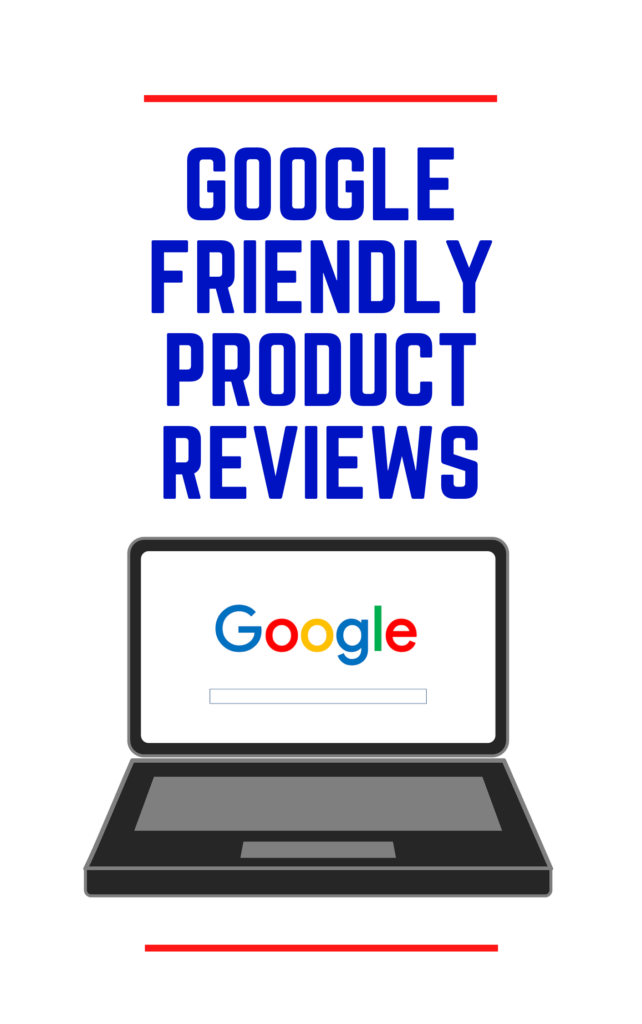How to Create Google Friendly Product Reviews
Every time there’s an update in how search engines (primarily Google) are ranking websites, it alarms site owners and niche marketers because they worry about seeing their site plummeting in the SERPs (search engine results pages).
Recently, there’s been a change in how Google rewards and penalizes sites with thin content when it comes to product reviews, specifically. Of course, they claim there’s no penalty – and technically, they’re right.
But when a site that adheres to their strategy is rewarded with higher rankings, it may cause a penalty by default when your site falls to the 10th page and is buried behind your competitors.

How Thin Reviews Let Consumers Down
This particular issue is going to affect thousands of affiliate marketers who were using their blogs to review tangible and digital products and earn a commission from their efforts.
There are two kinds of product reviewers. The first are genuinely sharing their insight, helping guide customers about the ins and outs of a product. The second are thin affiliates – slapping up the bare minimum facts and stats just hoping to get a sale.
There are many tools now that can simply scrape the manufacturer details listed about a product and turn it into a product review post on autopilot. There’s no human consideration, just an automated robot that can pump out so many reviews, it made the site rank higher than the marketers who took their time to develop a truly helpful one with substance.
What happened is, these thin automated sites were able to outrank the better ones in many instances, so consumers were left clicking on links to reviews with nothing more than the product listing told them.
When you’re truly hoping to get insight on which product to buy, you don’t want a rehash of the specs of the product – you want reasons why you should buy one item over another and comparisons to help you make that buying decision.
More and more consumers are buying online now, so not shopping in person means they’re more reliant on the stewardship of online affiliates whose opinions can help them make the best decision.
Google is aiming to separate the wheat from the chaff and allow bloggers who delve deeper into a product review to see rewards for their efforts. That means everyone who was getting by on thin promos will now have to step up their game if they hope to compete.
Google’s New Algorithm for Affiliates
In April of 2021, Google changed the way their system sees reviews and ranks them. From now on, thin reviews will fall to the bottom of the barrel, while in-depth reviews get preference in being presented to consumers.
The content in question will be anything on your site where you’re presenting it as a single product review, a product comparison review, a buying guide or other obvious review content.
Your site won’t suffer an official penalty, but rather wane in its ability to rise to the top of the SERPs from this point on. As Googlebots crawl your content, it won’t see the kinds of details it needs and therefore, won’t give you the boost you may have experienced previously.
If you ever created a blog post with a top 10 list of products, merely giving each one a regurgitated list of the same details the consumer can find on Amazon, then your post probably won’t be in compliance with their new algorithm.
This particular algorithm change is not part of Google’s core updates. What they’re hoping to do is give a bigger spotlight to those who serve their audience well – people who take time to know the subject matter and give a quality analysis.
Don’t mistake this to be a lesson that Google wants you to neglect the specifications of a product. In fact, they clearly say that they want product reviewers to be very clear about the identifiers of a product, such as a manufacturer, brand name or model number.

This allows the consumer to appropriately shop for the exact product you’re discussing in your review. So this is not an instruction to abandon the details you’re given with products – just a hint that you need to now expand on it far more than that.
This ranking change will not only affect entire product review sites, but also portions of your site, if only part of it contains product reviews. They want to avoid showcasing review sites with thin content, but also anything unoriginal.
For now, depending on your niche, you might be able to keep your head above water and not suffer any losses in traffic. But when another affiliate comes along who does adhere to the new Google standards, your site will be bumped from top ranking and they will siphon off the traffic and sales you’ve become accustomed to.
In order to prevent a significant drop in income, you need to begin developing product reviews in a way that not only pleases the search engine algorithms, but also makes consumers appreciate the work you’ve put into your review so they can reward you with a sale.
One thing you might be able to do is see where your competitors are failing to achieve progress with these new review guidelines and target the same keywords and phrases to get to the top of the SERPs.
For example, if you search the keyword phrase best weight loss cardio machine and only find thin reviews, go ahead and create an in-depth, Google-approved review for it and watch how you’re able to dominate.
What Your New Reviews Need to Include
There are some specific things you can do to sway the bots in your favor for a better ranking, in conjunction with this new algorithm. The first thing they want is for you to use the exact product name in your reviews, because this helps consumers ensure they’re buying the same product.
You want to go above and beyond the simple specs of a product and include your expertise and knowledge about the product or the use of it wherever you can. For instance, don’t just talk about the size, shape and functions – but share tips and advice about how to use it.
Most marketers go after a specific keyword or phrase when writing product reviews. You’ll often find those same phrases on the product pages themselves. But Google will be looking for other keywords – something fresh.
Use a keyword tool, common sense and brainstorming sessions to mix and match phrases and come up with something that tells Google your review should be set apart from other typical reviews on this product.
If you have the product and can showcase it, do that with pictures, videos and text that discusses it. Any time you can use your own pictures instead of the sales image on the product page, it convinces the consumer (and Google) to trust your review more.
For example, if you’re reviewing a Click N Grow 3-pod hydroponics garden, don’t just give the exact dimensions. Talk about how it’s no bigger than the size of a breadbox. Tell how easily it fits right on your work desk and how it allows you to have greenery that’s growing on autopilot surrounding you.
This is something the manufacturer won’t say. Something only you could offer as insight. You’re painting a picture for the audience, making them see the potential of the product in their own lives.
Your language should be the same as if you were writing the review for a friend who asked for your insight. Don’t be spammy and use sales copy in your product reviews. Google doesn’t want to send their users to site owners who are out to make a quick buck.
They want to send them to people who genuinely care about sharing their insight and advice – people who are enthusiastic about the niche topic and happen to be able to advice people on which products to buy.

Think like a consumer thinks – like you think whenever you go to shop for the best product to buy. When you are seriously considering which product to spend money on, you’re going to want to know how something stacks up against another product.
So maybe you want to know if a counter mixer can handle cookie dough easily or if the leaf blower you want to buy can really mulch the twigs scattered all over your yard. Talk about the performance measurements consumers want to know about and how this product compares to its competitors.
Be the type of affiliate who steps up to answer common questions people have about the product. Google gives you these on their search engine. If you type in ring doorbell questions, you’ll not only see websites discussing these, but Google itself has a section called “People also ask” which has questions like, “Can you use Ring without a subscription? Is there a monthly fee for Ring? Does the doorbell actually ring inside the house?” and more.
Answer these questions in your review and show the consumer and Google that you have given consideration to their concerns and want to cover everything in a thorough basis so they can make a smart shopping decision.
Even though you might be reviewing one product in particular, you may want to discuss other ones that are comparable. Talk about why they don’t measure up, why they’re equal products or why they might be a better investment if the consumer has the money for it.
Sometimes it’s a matter of circumstances. Maybe the mixer you’re reviewing is perfect for any ingredients, but another one takes up less counter space. It’s okay to offer advice for people in different circumstances, including financial means.
One thing you can look for is to see if the manufacturer has made any improvements or changes to the product since it originally launched. Sometimes, product reviews on sites like Amazon will discuss a feature that the company has since fixed, so you can address that in your review.
How to Renovate Your Old Reviews
There will be many affiliates whose time and effort building their review sites will be hit hard. Their traffic will tank because they did the bare minimum and didn’t bother to build for the consumer, but rather for rank.
If you made the mistake of targeting quantity over quality with your reviews, then you’ll want to change things from here on out. The bad part is, this may be a grueling process for you, depending on how many reviews spread across a variety of niche sites you have.

The good thing is, from here on out, your reputation among search engines and consumers alike will grow and your conversions will probably soar, since customers will not be gaining impressive knowledge over spammy facts they could have found for themselves on the sales page.
So what can you do right now as Google begins changing their ranking to reward in-depth, thorough and original reviews for products? First, take an assessment of everything that needs updating.
You don’t want to stick your head in the sand and ignore all of the work that needs to be done. Look at your most lucrative sites first, because you don’t want those to lose momentum in the SERPs.
As you analyze each site, look to see which posts and keyword phrases you’re ranking for best (and earning commissions off of) and shore those posts up so that they continue to work well for you.
Instead of looking at cutting anything (other than spammy hyped-up language), look at what all you can add to the post to help it continue performing in the SERPs. Start with personalization.
Do you have any personal experience with the product? If so, add your own insight to the post – what you liked, what you didn’t, what you wished you’d known or tips on how to make the most from your purchase.
Add images of the product that are original. And make a video too, if you can or want to add some multimedia effects. Showing it in use is a great way to set your review apart from others.
Go to Google and find which questions consumers want to know and answer them in the post with your own personal answers and insight to help address their concerns. Look in forums and in the comments of the product reviews listed on Amazon, too and see what features, questions and issues people are discussing about the product.
Make a schedule to revamp each and every review on your sites so that they adhere to the new guidelines in going above and beyond to serve your readers. Make sure that from this point on, you add the personalization and extra information needed to each new review posted to your site so that it performs well for you right out of the gate.
